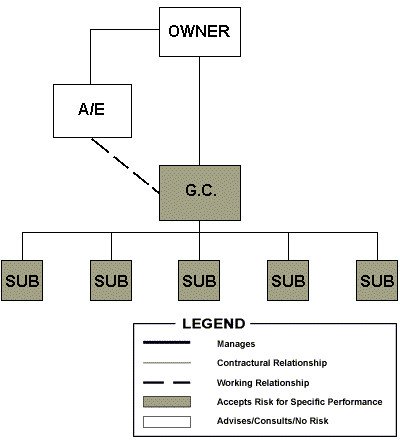General Contractor vrs. Construction Manager
Are you considering a project?
Comparison of GC,CM, and O&R Models
The General Contractor, Construction Manager and Owner’s Representative are the three main functions an owner / developer can utilize to get a project built. They are, however, very different in their approach to a project.
The Owner - General Contractor - Subcontractor model is the most conventional or orthodox method for building projects as evidenced by the following diagram:
Traditional General Contractor Model

**A/E (Design Consultants, typically Architects & Engineers)
In this model the owner assumes the least amount of risk, given that it is usually a fixed lump sum agreed upon price. The owner gives up the potential project savings, as profits to the General Contractor. This is a good model for inexperienced developers. This model does however also increase the risk of a competitive relationship between GC and owner, since the GC competes for profits within the fixed contract price.
The Owner - Construction Manager - Subcontractor model allocates more risk for the owner, however can also be the most rewarding by allowing the owner to avoid paying the GC mark-up on each of the subs, and benefitting from any project or construction savings along the way. However, it does not allow the security of a lump sum bid, since the risk of “unforeseen” or missed work scope is a burden of the owner and not the GC.
Construction Management Model

This model is only recommended for experienced Developers & Project Owners, or for those whose trusted relationship with a CM outweighs the perceived cost of associated project risks.
Project Understanding -- One of the key purposes of any contract is to allocate risks and benefits between the parties to the contract. In the construction context, various project delivery methods have been developed to deal with the different ways, owners, developers, contractors, consultants and public entities view and accept risk.
In determining who should assume any particular risk in a project the commercial parties need to understand what those risks are, and who is best able to control, manage, avoid or mitigate those risks.
Project Delivery Methods -- Have evolved to deal with the many ways in which contracting parties wish to allocate their risk, from the traditional stipulated lump sum price (general contract) to the development of alternative financing and procurement methods including P3 models. Each delivery method has its advantages and disadvantages, and it is the responsibility of the project owners to ensure that their interests are best served and are protected to the greatest extent possible against the risks that they have chosen to accept.
Stipulated Lump Sum Price / GC -- In considering alternative delivery methods, it is useful to look briefly at how a traditional project is structured. The traditional stipulated price or general contract project structure relies upon the owner first contracting with the consultant, who is responsible for the project’s design, including detailed drawings and specifications, preparation of the bid package or Request for Proposals (where appropriate) and, in some part, for the supervision and administration and certification of the work performed under the construction contract. The consultant’s contract is most often a fixed price and date certain contract. Through the consulting agreement, the owner gains the benefit of the consultant’s experience and expertise. Once the design has been completed and the work offered for tender or proposal, the owner will retain the general contractor, who is wholly responsible for the construction of the project in accordance with the consultant’s design. (See Diagram 1, page 1)
Construction Management -- The construction management framework is similar in many respects to a traditional construction contract. The difference comes by way of the introduction of the construction manager, who takes the place of the general contractor and has a modified role. In a “Pure” Construction Manager structure, the owner again contracts with a consultant to prepare a design and contract documents. Simultaneously, or subsequent to the completion of the design the owner will also contract with a construction manager as its agent for the management of the project. The construction manager’s role is predominantly one of advisor, administrator and project manager. In addition to assisting the owner with tendering and the selection of the various contractors who will complete the work, the construction manager will also administer the trade contracts (a role assumed by the contractor in a traditional project). The construction manager will be responsible for creating the project schedule and will assist the owner in developing the project budget. The owner relies on the technical knowledge of the construction manager. Depending on the expertise, experience and confidence of the owner, the construction manager may perform many of these functions with minimal oversight from the owner. Of huge significance and value however, is the retention of the construction manager in the early stages of the project. This allows the construction manager to assist the owner in its interactions with the consultant regarding the design of the project, with a bias and experience for “value engineering”. In this best practice, a construction manager can begin to engage trades and suppliers for some aspects of the project before the design is completely finalized.







